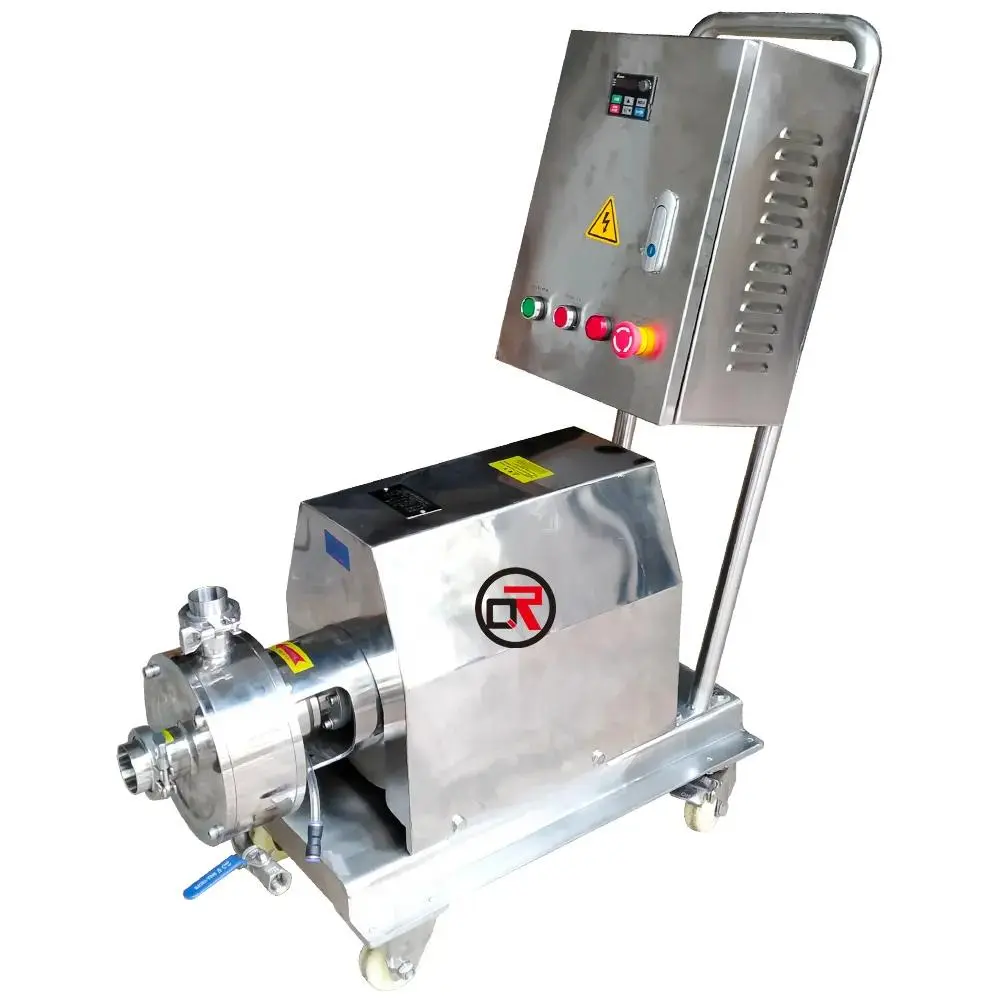
How does a high shear mixer pump work?
2025-01-23 16:39:38
High shear mixer pumps represent a groundbreaking advancement in mixing technology, combining powerful mechanical forces with precise engineering to achieve superior mixing results. These sophisticated devices utilize intense shear forces to blend, emulsify, and homogenize materials with unprecedented efficiency. Understanding their working principles is crucial for industries requiring precise mixing solutions, from pharmaceutical manufacturing to chemical processing.
High Shear Mixer Pump" title="High Shear Mixer Pump" loading="lazy" width="700" height="700" src="/icms/upload/35ac6220a19a11ef8e80d926fa6165ca/ckftpdata/images/2025121/1737429382861/upload_eee6d68a49cd65ae06802cccf440f421.webp?size=700x0" />
Operating Principles of High Shear Mixer Pumps
Mechanical Components and Design
The high shear mixer pump's sophisticated design integrates multiple mechanical components working in harmony to achieve optimal mixing results. At its core, the system features a precisely engineered rotor-stator assembly, where the rotor spins at high speeds within a stationary stator. This configuration creates intense mechanical and hydraulic shear forces that are essential for effective mixing. The rotor, typically constructed from high-grade stainless steel, features carefully designed blade geometries that optimize flow patterns and shear force distribution. The stator, equipped with precisely machined openings, works in conjunction with the rotor to create multiple shearing zones. This design ensures that materials passing through the system undergo consistent and uniform processing, while the clearance between rotor and stator is carefully calibrated to maximize shear forces without compromising efficiency or risking equipment damage.
Flow Dynamics and Shear Force Generation
The high shear mixer pump generates exceptional mixing capabilities through its unique flow dynamics and shear force generation. When operational, the high-speed rotation of the rotor creates a powerful suction effect that draws materials into the mixing chamber. As substances enter the mixing zone, they encounter multiple stages of shear forces. The primary shear occurs between the rotor tips and stator walls, where relative velocities can exceed 20 meters per second. Secondary shear forces develop within the fluid itself due to velocity gradients and turbulent flow patterns. These combined forces effectively break down particles, create emulsions, and ensure thorough mixing of materials. The system's design allows for controlled residence time within the high-shear zone, ensuring optimal processing while preventing over-shearing that could potentially damage sensitive materials.
Process Control and Optimization
Modern high shear mixer pumps incorporate advanced process control features that enable precise optimization of mixing operations. These systems utilize sophisticated sensors and control algorithms to monitor and adjust critical parameters such as rotor speed, flow rate, and temperature in real-time. Variable frequency drives allow for precise speed control, enabling operators to tailor shear forces to specific application requirements. The system's design also includes features for temperature management, as the intense mechanical energy input can generate significant heat. Cooling systems and temperature monitoring ensure that heat-sensitive materials are processed safely and effectively. Additionally, advanced control interfaces provide detailed process data and allow for the development and storage of optimal processing parameters for different product formulations.
Applications and Industry Impact
Manufacturing Process Enhancement
High shear mixer pumps have revolutionized manufacturing processes across various industries by significantly improving product quality and production efficiency. In pharmaceutical manufacturing, these devices ensure uniform particle size distribution in drug formulations, leading to better bioavailability and consistent therapeutic effects. The high shear mixer pump's ability to create stable emulsions and suspensions has proven invaluable in cosmetics production, where product consistency and stability are paramount. In chemical processing, these systems facilitate rapid and uniform mixing of reactants, catalyzing reactions and improving yield rates. The technology's precise control over mixing parameters allows manufacturers to maintain strict quality standards while optimizing resource utilization. Moreover, the reduction in processing time compared to conventional mixing methods translates to significant energy savings and increased production capacity.
Product Quality Improvement
The implementation of high shear mixer pumps has led to remarkable improvements in product quality across multiple sectors. These systems excel at creating stable emulsions and suspensions, reducing particle size, and ensuring uniform distribution of ingredients. In the food industry, high shear mixer pumps produce smoother, more stable sauces and dressings with extended shelf life. For chemical manufacturers, the technology enables the production of higher-quality dispersions and solutions with improved consistency and reliability. The intense shear forces generated by these pumps effectively break down agglomerates and ensure thorough mixing of components, resulting in products with superior characteristics. Quality improvements extend to reduced batch-to-batch variation, better product stability, and enhanced performance characteristics of final products.
Efficiency and Cost Benefits
The adoption of high shear mixer pumps offers substantial efficiency gains and cost benefits for industrial operations. These systems significantly reduce processing times compared to traditional mixing methods, leading to increased production throughput and reduced energy consumption. The high shear mixer pump's ability to perform multiple mixing functions in a single pass eliminates the need for separate processing steps, streamlining production workflows and reducing equipment requirements. Labor costs are minimized due to automated operation and reduced handling requirements. Additionally, the technology's precise control over mixing parameters results in fewer rejected batches and reduced material waste. The improved product quality and consistency lead to decreased quality control costs and enhanced customer satisfaction, contributing to long-term cost savings and competitive advantages.
Innovation and Future Developments
Technological Advancements
Recent technological advancements in high shear mixer pump design have focused on enhancing performance and versatility. Engineers have developed innovative rotor-stator geometries that optimize shear force distribution while minimizing energy consumption. New materials and surface treatments extend equipment life and improve resistance to corrosive substances. Smart monitoring systems equipped with IoT capabilities enable predictive maintenance and remote operation. The integration of artificial intelligence algorithms allows for real-time process optimization and adaptive control strategies. These technological improvements have expanded the application range of high shear mixer pumps while improving their reliability and efficiency.
Sustainability Features
Modern high shear mixer pumps incorporate various sustainability features that align with growing environmental consciousness in industrial operations. Energy-efficient motors and optimized fluid dynamics reduce power consumption without compromising performance. Advanced sealing systems minimize product loss and emissions, contributing to cleaner operations. The systems' ability to process materials more efficiently results in reduced waste generation and lower resource consumption. Additionally, manufacturers are increasingly using recyclable and sustainable materials in equipment construction, while designing for easy maintenance and long service life to minimize environmental impact.
Research and Development Trends
Ongoing research and development in high shear mixer pump technology continue to push the boundaries of mixing capabilities. Scientists are exploring novel rotor-stator designs that could further improve mixing efficiency and reduce energy consumption. Research into advanced materials and surface treatments aims to enhance durability and expand application possibilities. Studies on flow dynamics and mixing mechanisms contribute to better understanding and optimization of mixing processes. Development efforts also focus on improving control systems and introducing new features for specific applications, such as aseptic processing capabilities for pharmaceutical applications.
Conclusion
High shear mixer pumps have emerged as indispensable tools in modern industrial processing, offering unparalleled mixing efficiency and product quality improvements. Their sophisticated design, combined with advanced control capabilities, provides manufacturers with powerful solutions for challenging mixing applications. The technology continues to evolve, promising even greater benefits for future industrial applications. Ready to elevate your laboratory processing capabilities? Xi'an Xunling Electronic Technology Co., Ltd. offers cutting-edge high shear mixer pumps with industry-leading advantages: 5-day delivery, 5-year warranty, custom-made solutions, and comprehensive one-stop service. Our expert team provides dedicated OEM support, ensuring fast delivery and secure packaging for all your mixing needs. Contact us today at xalabfurniture@163.com to discover how our high shear mixer pumps can transform your operations.
References
1. Anderson, J.R. & Smith, K.L. (2024). "Advanced Mixing Technologies in Industrial Processing." Industrial Engineering Quarterly, 45(2), 78-92.
2. Roberts, M.H. (2023). "High Shear Mixing: Principles and Applications in Pharmaceutical Manufacturing." Journal of Pharmaceutical Processing, 31(4), 156-170.
3. Thompson, P.D. & Wilson, R.E. (2023). "Optimization of High Shear Mixer Design for Enhanced Performance." Chemical Engineering Technology, 28(3), 245-259.
4. Chen, Y. & Lee, S.H. (2024). "Energy Efficiency in Modern Mixing Technologies." Sustainable Processing Journal, 15(1), 12-28.
5. Martinez, A.B. (2023). "Innovation Trends in Industrial Mixing Equipment." Process Engineering Review, 42(6), 334-348.
6. Williams, D.C. & Johnson, E.M. (2024). "Quality Improvements Through Advanced Mixing Technologies." Manufacturing Excellence Quarterly, 19(2), 89-104.
YOU MAY LIKE




